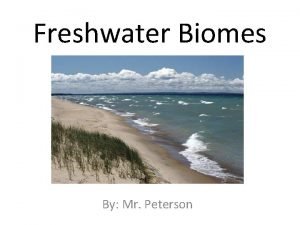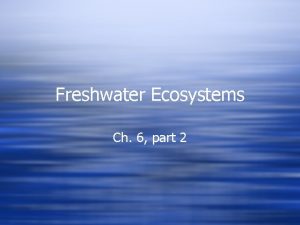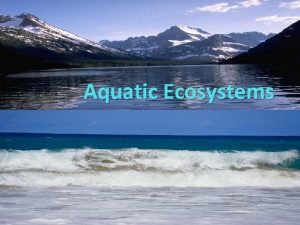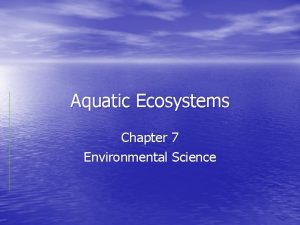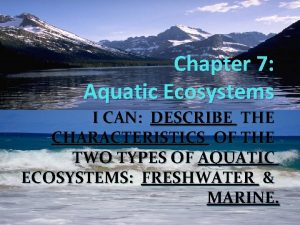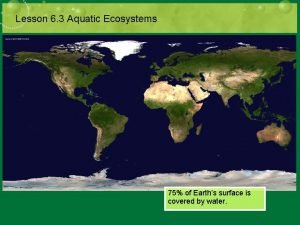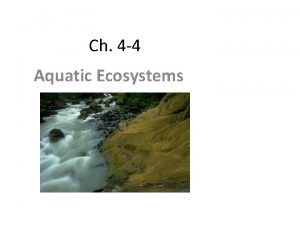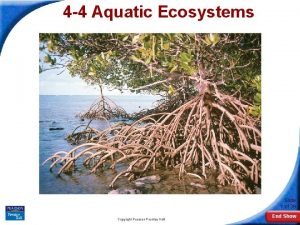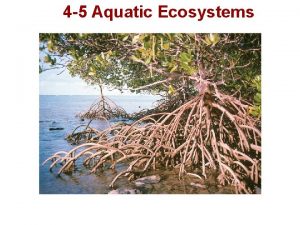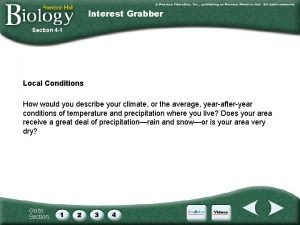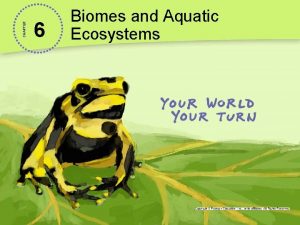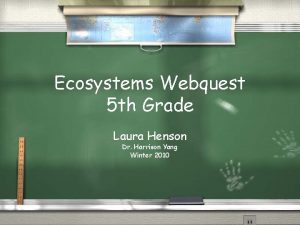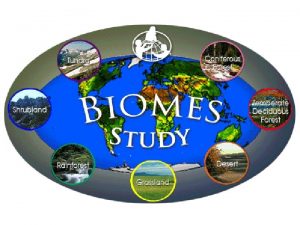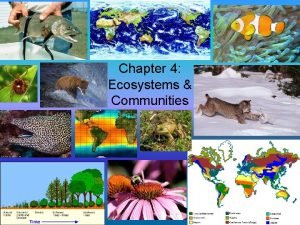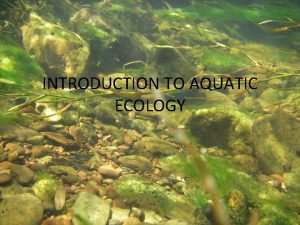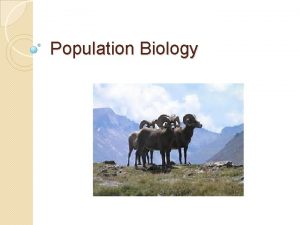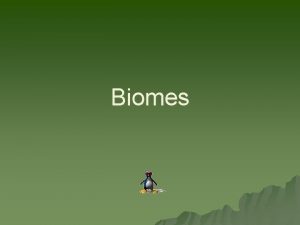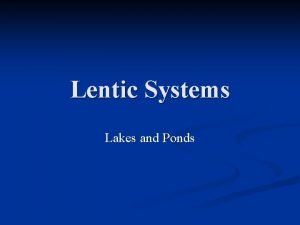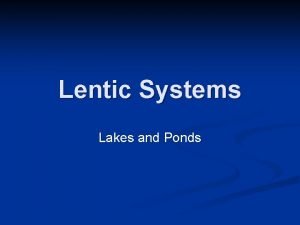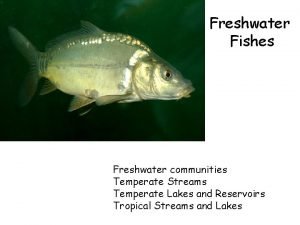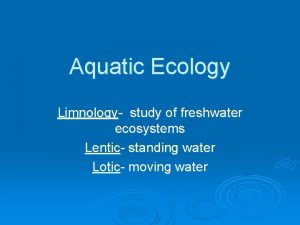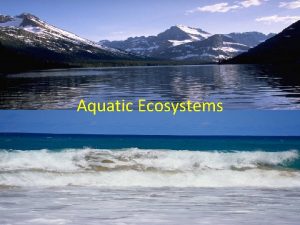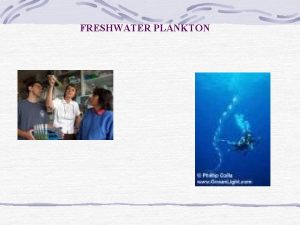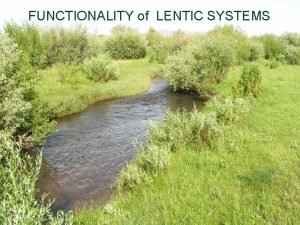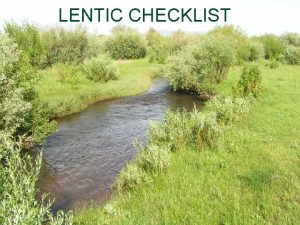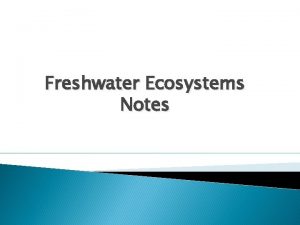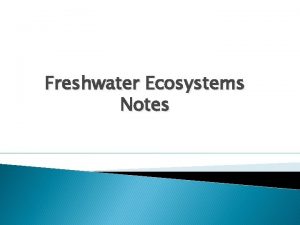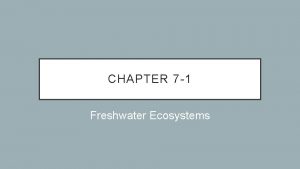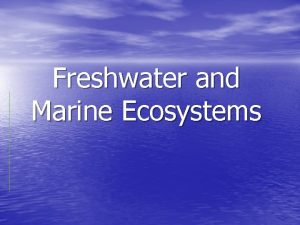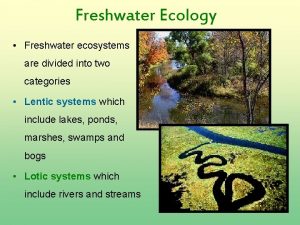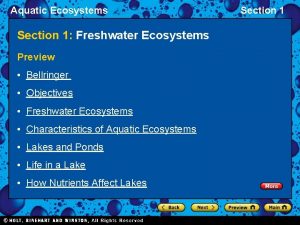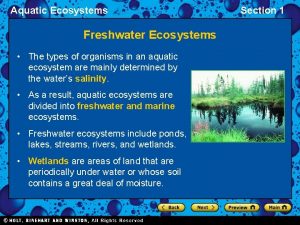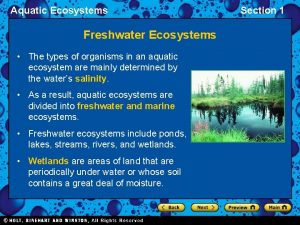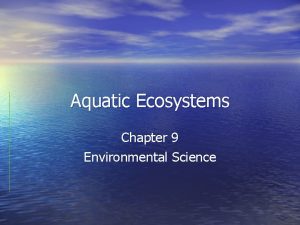Aquatic Ecology Limnology study of freshwater ecosystems Lentic































- Slides: 31

Aquatic Ecology Limnology- study of freshwater ecosystems Lentic- standing water Lotic- moving water

Lentic Ecosystems Depressions in land 12, 000 meters deep Ø In northern hemispheres, glaciers left behind carved out basins that filled with rain and snow Ø Other causes include: Ø l l Silt, driftwood and other materials that block the flow of streams Streams that were flat get cut off to create “oxbows”

Lentic Ecosystems Ø Craters from extinct volcanoes fill with water

Lake Formation Many lakes are formed by one of two mammals Ø Humans- dam rivers for power, irrigation, digging Ø Beavers- dam streams to form shallow ponds or lakes Ø

Lake Layers Ø 3 layers l l l Epilimnion- “upper lake” consists of a free circulating upper layer Metalimnion- also called thermocline or “middle lake” has a rapid decline in temperature (1 degree Celsius for every meter you go down) Hypolimnion- “lower lake” is the deep, colder layer

Lake Structure Littoral zone- shallow water zone, light reaches the bottom and it usually has plants Ø Emergents- plants whose roots and stems are in water but upper stems and leaves are out of the water Ø Limnetic or Pelagic zoneopen water, and has Ø l l Plankton- suspended organisms Nekton- free swimming fish

Lake Zones Benthic zone- sediment on bottom of lakes and ponds • Photic zone- where light penetrates to the bottom • Aphotic zone- under water area where light does not reach • Eutrophic- nutrient rich • Oligotrophic- nutrient poor • Hypertrophic- excessive nutrients

Lake Temperatures Ø Summer/Spring l Water is warm on top and cold on bottom

Lake Temperatures Ø Fall/winter l l Temperature on surface drops and metalimnion sinks Epilimnion increases until all water is the same temperature Water circulates oxygen and nutrients Overturn- seasonal mixing of water

Water Chemistry Dissolved Oxygen (DO) Enters the water through the atmosphere and photosynthesis Ø Amount of oxygen the water can hold depends on pressure, temperature, and salinity Ø Cold water holds more oxygen that warm water Ø As atmospheric pressure increases, so does the amount of oxygen in the water Ø Oxygen absorbed by the surface is mixed by turbulence of internal currents Ø Overturn replenishes oxygen in the water Ø Ø

Water Chemistry Ø Carbon Dioxide Ø Carbon dioxide is usually the same concentration as that in the atmosphere

Water Chemistry Ø Ø Ø p. H A measure of the acidic or basic the water is On a scale of 1 -14 1 is very acidic and 14 is very basic 7 is neutral l Freshwater 3 -10 Rainwater 5 -6 Streams and lakes 6. 5 -8. 5 Limestone under the water causes the p. H to increase Ø (or become more basic) Ø

Lotic Ecosystems Ø Flowing water (rivers and streams) Ø Velocity and current decide most things because it cuts channels and affects living organisms Ø Velocity is determined by size, shape, gradient of the channel, roughness of bottom, depth, and precipitation

Streams Ø May begin as outlets of ponds or lakes Ø Flow is determined by the lay of the land if the stream has not been disturbed Ø As water flows, it picks up debris that scrapes the bottom and makes the stream bigger

Terms Meander- bends in streams (aka. Sinuosity) Ø Watershed- body of land where all runoff collects in a common body of water Ø Turbidity- the amount of particles suspended in water prohibiting light to shine through Ø Channel- the stream bed and banks formed by flowing water Ø Flood Plain- a strip of land that is normally dry and flat that is on the sides of a river or stream and is wet during floods. Ø

Terms Riparian Zone- the land vegetation bordering flowing or standing water Ø Riffle- a section of a stream where the water is shallow, fast moving, and is broken into waves by an obstruction Ø Siltation- deposition of fine particles (silt) on the beds of streams or lakes Ø Pools- water that is relatively deep Ø Bankfull Width- where water will stop if it comes out of the stream Ø

How can you tell if a stream is healthy? Ø 1. Stream Quality is determined by Area cover Do things hang over the stream? 2. Embeddedness Are there dirt particles on the bottom? 3. Depth Is the stream shallow or deep? 4. Sediment deposits Are there sediment build ups? 5. Channel flow Does water fill up the channel?

Stream quality continued… 6. Channel Alteration Has concrete, rock, or anything else been added to the stream? 7. Frequency of riffles or bends Does the stream curve or have any white water? 8. Bank stability Are the banks falling into the stream? 9. Vegetative Protection (on the banks) Are there plants growing on the banks? 10. Riparian zone width How big is the area on the bank where plants grow?


Stream Chemistry Ø p. H • A range of 6 -9 is ideal for running freshwater fish and bottom dwelling invertebrates • Synergistic Effects Ø Happens when two things combine to produce effects greater than their sum Ø Example. ) Pollutants can change the p. H of a stream

Stream Chemistry Ø Ø Dissolved Oxygen (DO) If dissolved oxygen drops below 5 mg per liter, aquatic life is stressed The lower the concentration, the more stress Levels below 1 -2 mg per liter for a few hours result in “fish kills”

Stream Chemistry Ø BOD (biochemical oxygen demand) l l The amount of oxygen needed for decomposition If there is little oxygen, decomposers that use it will die Too much oxygen causes “gas bubble disease” Rare • Oxygen blocks blood vessels • Can see bubbles on the fins and the skin


Stream Orders Streams join together to form rivers. Each time one stream joins another “order” changes. Ø A first order stream is one that does not have any other stream joining it. Ø A stream can only increase in order if a stream of a similar order joins it. Ø l For example, when a first order stream runs into another first order stream, it becomes a second order stream. Likewise, when two second order streams join each other, it becomes a third order stream and so on.

Stream Orders Order is not increased when a lower order stream joins one of a larger order. Ø Generally: Ø l l l First through third order streams are usually called headwater streams Fourth through sixth order streams are usually called medium-sized streams Above sixth order, the streams become rivers Lower order streams are usually on steep slopes compared to higher order streams Ø Higher order streams have flood plains Ø

Ø A watershed is a section of land where all the water runoff flows into a common basin.

Stream Restoration Ø There are many aspects to stream restoration, but some suggestions would be: l Decrease the slope of the banks (if it will not compromise or eliminate the riparian zone). This is generally accomplished by using a 3: 1 ratio. Stream 3 ft. 1 ft. Bank • Reduces the stress on channel walls from flowing water • Becomes more stable • Stops erosion and sedimentation • Creates a surface for vegetation Stream 3 ft. Bank 1 ft.

Stream Restoration l Stabilize the Stream Banks • Riparian Forestation l Plant native vegetation on the stream banks to stop erosion. The roots of the plants will hold the soil onto the banks. • Add big structures to the banks like wood, stone, or fabric that will not wash away. Fabric provides a surface to hold planted vegetation. • Drive posts into the bank to keep soil from eroding into the stream. • Make the channel bigger.

Stream Restoration l Construct riffles and pools • Adding large rocks and/or other materials from the site to the stream prevents natural areas from being disturbed by trucks hauling rock to the stream. l l Allows more DO to enter the water Slows the velocity of flowing water • Before adding rock to the stream, organic matter must be cleared from the bottom to be sure the rock will be stable. • The rock must be lower than the bank.

Stream Restoration l Cut and Fill • Widening the channel in a particular area to allow water a larger surface to pass over • If the channel has been cut very deep, the water will not be able to get into the flood plain. By adding rock to the bottom of the channel, the water level is raised allowing it to reach the flood plain if needed.

Stream Restoration l Add a waterfall • Create a difference in elevation allowing the water to fall. This will increase DO, slow the flow of the water, and create a habitat for aquatic life. l Remove garbage
 Mardu graw
Mardu graw Freshwater biomes facts
Freshwater biomes facts Human impact on freshwater ecosystems
Human impact on freshwater ecosystems Section 1: freshwater ecosystems
Section 1: freshwater ecosystems Limestone ridges built by tiny animals
Limestone ridges built by tiny animals Marine ecosystem webquest
Marine ecosystem webquest Lesson 3: aquatic ecosystems
Lesson 3: aquatic ecosystems Section 4-4 aquatic ecosystems
Section 4-4 aquatic ecosystems Section 4-4 aquatic ecosystems answer key
Section 4-4 aquatic ecosystems answer key 4-4 aquatic ecosystems
4-4 aquatic ecosystems Chaparral biomes are generally _______.
Chaparral biomes are generally _______. Section 4-2 what shapes an ecosystem answer key
Section 4-2 what shapes an ecosystem answer key Aquatic vs terrestrial
Aquatic vs terrestrial Lesson outline lesson 2 aquatic ecosystems answer key
Lesson outline lesson 2 aquatic ecosystems answer key Chapter 7 aquatic ecosystems test answers
Chapter 7 aquatic ecosystems test answers Biomes and aquatic ecosystems
Biomes and aquatic ecosystems Ecosystems webquest
Ecosystems webquest What factors describe aquatic ecosystems
What factors describe aquatic ecosystems Section 3 aquatic ecosystems worksheet answers
Section 3 aquatic ecosystems worksheet answers Biomes and aquatic ecosystems
Biomes and aquatic ecosystems Chapter 3 lesson 3 biomes and aquatic ecosystems
Chapter 3 lesson 3 biomes and aquatic ecosystems Section 4-4 aquatic ecosystems
Section 4-4 aquatic ecosystems Aquatic ecology definition
Aquatic ecology definition Chapter 55 ecosystems and restoration ecology
Chapter 55 ecosystems and restoration ecology Chapter 55 ecosystems and restoration ecology
Chapter 55 ecosystems and restoration ecology Lentic ecosystem
Lentic ecosystem Lentic ecosystem
Lentic ecosystem Lentic lake
Lentic lake Littoral limnetic
Littoral limnetic -is an example of a lentic ecosystem.
-is an example of a lentic ecosystem. Chapter 5 how ecosystems work study guide
Chapter 5 how ecosystems work study guide Study guide chapter 3 section 1 community ecology
Study guide chapter 3 section 1 community ecology

